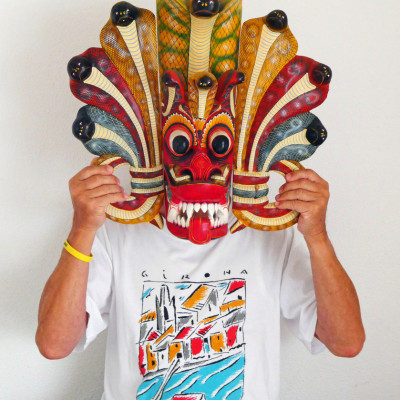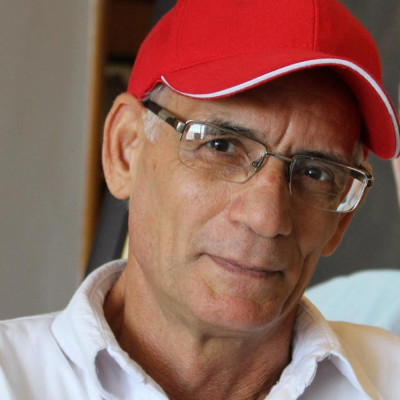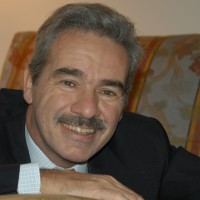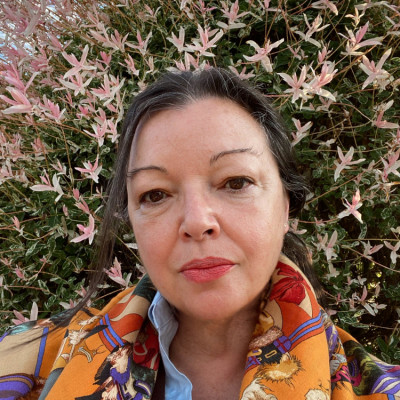SEARCH






|
|
|
|


by Editor Miro Susta
Edited and published by Yvette Depaepe, the 6th of April 2022
This is the fifth part of our trip around the world in which we will visit the Americas and Caribbean.
The Americas are made up of North and South America. Between them is a narrow strip of land generally referred to as Central America.
'A Glowing Pearl' by Andreas Agazzi
America was discovered by Italian explorer and navigator Christopher Columbus in 1492. In 1507 the German cartographer Martin Waldseemüller named the Americas double continent after merchant and explorer-navigator Amerigo Vespucci, who explored much of South American east coastline during 1499 and 1502. The proposal initially applied only to South America. However, the suggestion was well received and the extension of the name to North America came later.
'Caribbean Symphony' by Hans-Wolfgang Hawerkamp
At this point I would like to clarify the fact that the Caribbean region is not part of Americas, but nevertheless is constitutes a segment of this article.
'Hawksbill turtle swimming through Caribbean reef' by Jan Abbadschieff
The magnificent scenery and fascinating history of the Caribbean has not escaped the attention of UNESCO experts. They have included several Caribbean regions and attractions on their list.
'Patagonia Mountain Light' by Yan Zhang
Patagonia covers most of Argentina and extends into Chile. It is a region that crosses the boundaries of counties, nations, mountain ranges and rivers. It extends from the tropics in the north to the Tierra del Fuego and the ice-covered south.
It can be divided into several regions, such as the Andean, Atlantic, Central and Tierra del Fuego.
It is said that its name comes from the time when Magalhães first came to this region and saw the Patagonians - " the Giants " - because the average height of the population was considerably taller than that of the Spaniards.
'Nightfall in the Favela da Rocinha' by Adelino Alves
Favelas have existed in Brazil since the end of the 19th century. After the abolition of slavery in 1888, countless freed slaves and discharged soldiers built their own homes on the outskirts of Brazilian cities using makeshift materials. The resulting neighbourhoods were named after the species of trees by which they were surrounded. Today, it is estimated that 12 million Brazilians live in favelas.
'Torres del Paine' by Alex Saberi
Chiles National Park Torres del Paine seems to be made for photographers. This unique corner of the Earth is described by many as the place where the end of the world begins. But what ends here is civilization. It's often just you, the endless plains and the harsh weather. Still, the journey here is worth it!
Beautiful scenery and places that look like they are from another world. Raw and beautiful nature shows its face here in the form of lakes, unforgettable mountain scenery, bright blue glaciers or a rich and varied representation of flora and fauna.
'Machu Picchu' by Helena Normark
Peru’s Machu Picchu - the magical city of Incas. The only thing that has kept it from destruction is that it is located deep in the mountains at an altitude of 2’430 meters above sea level. Getting here is challenging but it is worth every hour spent on the road to reach this magic place.
We may never know what the real, original name of this Lost City was; only the time of its creation is known. The Incas built it at the time of their greatest glory and prosperity, around 1460 to 1470 BC.
'Mountains in the Salavador Dali Desert-Bolivia' by Hernan Calderon Velasco
Salvador Dalí!, a dozen rocks in the sand desert. Shaded from light to dark brown, they are scattered widely on a hillside, as if a few stones of gravel had fallen out of God's pocket. These are the “Dali Rocks", as taken from a painting by the Spanish artist, all located in Bolivian Salar de Uyuni, the largest salt desert in the world.
'Catedral Metropolitana' by Miro Susta
Also called the Cathedral of Guatemala City, the Metropolitan Cathedral sits right in the heart of the city and boasts an interior design that stands as a shining example of colonial art and architecture. The layout reflects the form of a Latin Cross, while the twelve columns in front of the cathedral are a tribute to the murders and disappearances of thousands of people during the Guatemalan Civil War during the 1960s. Inside the cathedral are fourteen paintings by the revered 17th-century Mexican artist Pedro Ramirez.
'Welcome home!' by Young Feng
Costa Rica is a relatively small country located in the Neotropics, but it is rich in many species of birds. The official list of birds published by the Costa Rican Committee for Rare Birds and Records of the Asociación Ornitológica de Costa Rica (AOCR) contains 923 species.
'Keel-billed' Toucan by Fabio Ferretto
Toucans are the one of the most beautiful birds of the rainforest. When a Toucans are flying, it looks like a banana is sticking out of their head.
In Nicaragua, the two most common species of Toucans are living, the Keel-billed Toucan and the Chestnut-billed Toucan.
Although similar in coloration, these two types of Toucans have completely different sounds. The Keel-billed toucans croak like frogs and the Chestnut-billed toucans cry like seagulls.
All Things Great and Small by Toni Rath
Belize, the mysterious world of the Mayan civilization, a land of incredible diversity of marine organisms, the region of the second largest barrier reef in the world. Coral atolls along the barrier offer a home to the most diverse marine life in the world.
'The Have’s and Have Not’s' by Tony Mearman
Less than 160 kilometres off the coast of Florida lies the island of Cuba where the world's largest collection of classic American cars from the 1940s and 1950s can be seen. Thousands of pre-1960 cars roll out onto Cuban roads every day: Fords, Chevrolets, Buicks, Lincolns, Oldsmobile and Cadillacs - they're all here, as if lost in time, a relic of a time when Cuba was an American resort.
'Anna and the Sharks' by Thomas Marti
Get as close to the sharks as you never dreamed possible, the Bahamas is unfortunately becoming a shark tourism hotspot thanks to the presence of a diversity of species. The Bahamas is one of the most important areas for sharks, an area where scientists are working to preserve the healthy living conditions and protect these aquatic predators.
'Street Stories-Toronto' by Jackson Carvalho
Toronto is known as the most multicultural city in the world - and believe me it is proud of it. Walking through Toronto means travelling half the world.
When the weather is fine, Toronto is a blast: a vibrant, big-time city abuzz with activity. Some of the world's finest restaurants are found here, alongside happening bars and clubs and versatile festivals.
'Moving snow' by Miro Susta
During wintertime around 180 people work on snow removal in 12-hour shifts at Toronto Pearson International Airport. Each shift team operating up to 30 pieces of equipment for ploughing, sweeping, snow-blowing and surface treatment. In addition, a full backup team is always on call to provide extra support as needed. Work conditions can be tough. While equipment operators ride in heated cabs, others – from crews shovelling snow around the gates to electricians maintaining the runway lights – often face temperatures in the minus double-digits, with wind-chill effects that feel even colder. Available high-performance snow blowers can remove up to 7,500 tonnes snows in a hour.
In the teeth of cold wind by Yvette Depaepe
Victor Hugo once urged the French to give up colonial expeditions to certain North American countries, saying: "Why does France need this huge chunk of ice?" Even now some people say that Canada is a kind of American Siberia; permafrost and bitter cold prevail there, and Canadians live almost all year round by the fireplace and do not get out of their ski suits and jackets. Yes, winter in Canada and also in Quebec City can be a real burden, but the good news is that Quebec City has a mostly dry winter and does not have the wet bite that some other famously freezing regions of the country have.
'Show me the way' by Jabi Sanz
Peggy's Bay is a small rural community located on the eastern shore of St. Margarets Bay, in Nova Scotia, where the Peggys Lighthouse is located. This is a crash site of Swissair Flight 111 on the way from New York to Geneva on September 8th, 1998, eight kilometres from shore of Peggy's Cove.
'Assiniboine drama' by Daniel Kordan
At 3’618 metres, Mount Assiniboine, located on the British Columbia/Alberta border is the highest peak in the southern part of the Canadian Rockies. Because of its pyramid-like shape, this dominant mountain is nicknamed the Matterhorn of North America.
'Lake House sunrise' by Jesús M. García
Emerald Lake, located in the Rocky Mountains of Alberta, is a beautiful and easily accessible place in Yoho National Park. It was discovered by accident by Canadian guide Tom Wilson in 1882. The lake is of glacial origin and therefore has a bright emerald colour. Its surface mirrors the snow-capped peaks of the surrounding Emerald Peak and Wapta Mountain.
'Different twins' by Marco Pozzi
The nickname "Polar Bear Capital of the World" has been given to Hudson Bay because of the large number of polar bears that move inland to the coast in the autumn. It is one of the few places in the North American region where these usually solitary animals congregate in large numbers.
'fading away' by Simon Roppel
The Kaskawulsh Glacier is a large valley glacier in the Saint Elias Mountains. It is located in Kluane National Park, Yukon Territory, Canada. It extends from 2'000 to 3'000 metres above sea level over an area of approximately 25'000 km². The Glacier has retreated about a mile up its valley over the past century. The area around it is uninhabited.
'Golden Gate to Stars' by Javier de la Torre
The Golden Gate Bridge connects San Francisco and all Southern California to the north of the state. More than 2 billion cars have crossed the bridge since it opened in 1937, and the billion-US Dollar mark was passed on February 22, 1985. Approximately 115'000 cars cross the Golden Gate Bridge every day.
The billions are also the amount of money it would cost to build the bridge now. Building the Golden Gate Bridge today would cost about 1.6 billion US Dollars.
'Balanced rock' by Gary Perlow
Big Bend National Park is located in the south-western part of Texas near the border with Mexico. It is made up of desert, mountains stretching into Mexico, and the Rio Grande / Río Bravo River, which marks the border between the two countries. The park's name, Big Bend, comes from one of the bends in the river.
The main attraction of Big Bend Park is the rock formations scattered across the desert, often flooded by water from the Rio Grande.
'Bright Hoodoos' by Lydia Jacobs
The rock formations nicknamed "Hoodoos" in Bryce Canyon National Park are unique. Bryce Canyon was recognized as a national park in 1928 and is located in south-western Utah, about 400 miles from the famous Las Vegas. The fact that it has “Canyon” in the name is a bit misleading, because the main attraction is not the gorge, but the huge rock formations that literally form amphitheatres.
'The Confluence' by John W Dotson
The Grand Canyon of the Colorado River in Arizona is one of the Seven Natural Wonders of the World. It is the second largest canyon in the world with a length of 446 km and a valley depth of up to 1’600 metres. In the past, the Grand Canyon was considered by the indigenous Hopi people as a place through which man passes into the afterlife.
'Mt Sneffels in Autumn' by Mei Xu
At 4'315 meters, Mount Sneffels is the 25th tallest mountain in the Colorado Rocky Mountains. It is located in the Mount Sneffels Wilderness area in south-western Colorado. Mount Sneffels, consisting of intrusive rocks, intruded into weaker volcanic rocks about 20 million years ago. Sneffels's harder rock eroded less slowly than the surrounding volcanic rock, so the mountain stands taller than its neighbours.
'The clock' by Anette Ohlendorf
The true symbol of America is New York, also known as the "Capital of the World" or "Big Apple". New York was founded in 1625 and was the first capital of the United States. Today, this metropolis of 19 million is the centre of all the world's business, politics and culture.
New York is a veritable Babylon, where it is almost 100% true that two people sitting next to each other on the subway are of at least different national origins. New York is the city that never sleeps.
'Vermont: Through the fall' by Grant Hou
This is the end of the fifth article from our journey, during which we have visited destinations in Europe, Asia, Africa, Australia & Oceania and the Americas & Caribbean. We have seen photographs from fascinating and breath-taking destinations around the world.
'In search of fish' by Miroslaw
But this is not the end of our journey. The last article will be devoted to places that only a few privileged visitors can visit and see, a region that is not permanently inhabited, the cold & freezing Arctic and Antarctica.
www.mrsphoto.net
[email protected]
Links to previous articles
[4] A Journey through Europe's Beauty and Diversity (1x.com)
https://1x.com/magazine/permalink/9276
[4] Incredible Asia (1x.com)
https://1x.com/magazine/permalink/9294
[4] The 'unknown' Africa: an amazing continent (1x.com)
https://1x.com/magazine/permalink/9321
[4] Oceania : A World of a Thousands of Islands (1x.com)
https://1x.com/magazine/permalink/9334
 | Write |
 | Jabi Sanz amazing selection and so proud and glad to be part of it. Thank you so much |
 | Miro Susta CREW You are most welcome Jabi, sorry for delayed response |
 | Giorgio Pizzocaro PRO Beautiful selection of images!
Congratulations to the authors! |
 | Miro Susta CREW Many thanks Giorgio |
 | Ramzi Nari Appreciate your great work! Congratulations |
 | Miro Susta CREW Many thanks Ramzi. |
 | Andreas Agazzi PRO As usual a mindful selection of great photographs. Cheers Yvette and Miro for another effort, you deserve our respect for what you do! |
 | Miro Susta CREW Many thanks Andreas for your nice words, we appreciate it very much. |
 | Yanyan Gong PRO A beautiful display of the diverse landscape and history/geography lessons at the same time. I have enjoyed reading this article so much! Thank you very much Yvette and Miro! |
 | Miro Susta CREW You are most welcome Yanyan, we are glad to see that you enjoyed it. |
 | Izabella Végh PRO Bellissimo servizio con altrettanto fotografie valide. |
 | Miro Susta CREW Grazie mille per le tue belle parole Izabella |
 | Alberto Fasani PRO thank you, great article!! Looking forward to the next (hopefully not final) one |
 | Miro Susta CREW You are most welcome Alberto. Don't worry, we will continue with our traveling in the future. |
 | Francisco Goncalves PRO A fantastic complication of very well composed and defined images. Regarding the history of the Americas discover, I believe some historians would contest your conclusions. Nevertheless, great work. |
 | Miro Susta CREW Many thanks Francesco. I know there are many open questions about t American history. |
 | Mei Xu PRO Miro and Yvette, thank you so much for this beautiful and knowledgeable article. Learned a lot. BTW, Mt. Sneffels is now printed on Colorado drive licenses. |
 | Miro Susta CREW Many thanks for your appreciation Mei. Thank you for the additional information. |
 | Ludmila Shumilova PRO What a fascinating voyage through the gallery of selected pictures! Thank you so much, Miro and Yvette! Amazing photography! |
 | Miro Susta CREW Many thanks dear Ludmila for your very nice words of appreciation.. |
 | Anette Ohlendorf PRO Another interesting article with excellent selected pictures! Thank you very much for including a picture with this selection!
Many thanks to Miro, and also to Yvette for the publication.
anette |
 | Miro Susta CREW to |
 | Miro Susta CREW Many thanks dear Anette, I am glad to see that you like it. |
 | Hans-Wolfgang Hawerkamp PRO much remarkable article with a fantastic selection of images. My admiration to the Editor Miro and also to Yvette for publishing. Regards Hans-Wolfgang |
 | Miro Susta CREW Many thanks for your great words, I am happy to see that you like it Hans-Wolfgang. |